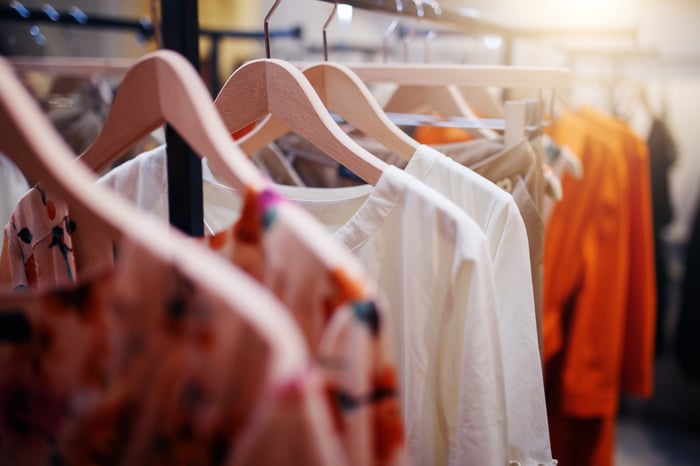Digital luxury consignment marketplace The RealReal (REAL 1.34%) has made a name for itself as a top destination for fashionistas, thanks to its huge inventory of pre-owned luxury at lower prices. Unfortunately for The RealReal, its own stock price has also gotten a steep markdown, and with growing losses alongside rising revenue, it's not very hard to see why. The company's problems have persisted for far longer than its latest quarter, and while The RealReal's guidance predicts it'll reach profitability 2024, it'll have to overcome significant operational and competitive challenges to get there.
One of many websites competing for the attention of fashion- and budget-conscious consumers, the RealReal focuses on listings of pre-owned clothing and accessories from luxury brands like Cartier and Gucci. People looking to clean out their closets for cash can work with a diverse array of resale websites, some of which sell pretty much everything, while others focus on a specific type of fashion. While all these websites are different, they share the common theme of helping pre-owned fashion exchange hands on the resale market, often at lower prices than the original purchase, while taking a cut of each sale. However, The RealReal has expenses most of its competitors do not have, thanks to the authentication process it relies on to gain customers' trust that the items they buy are the real thing. No one wants to spend a few thousand on a Dior bag, only to find out it's counterfeit.

Image source: Getty Images.
Best-in-class authentication
According to The RealReal, it has the most rigorous authentication process in the marketplace. The RealReal is the only resale company in the world that authenticates every single item it sells. Job postings for authenticators discuss locating holograms and date codes; evaluating the materials and craftsmanship of consigned items, and lifting and standing in a warehouse environment. This is work for humans, which means expenditures on the payroll. And the volume those humans must deal with is no joke. In October 2019 alone, The RealReal received nearly 490,000 products for consignment.
The expenses don't stop there. More humans have to receive and organize products, and The RealReal must pay real estate costs to store those goods. Copywriters create descriptions for products while photographers create professional photographs of the products, valuation experts decide what everything is worth, and then fulfillment staff package and ship purchases to their new owners.
In comparison, a sale made through mainstream fashion resale marketplace Poshmark (POSH) involves a lot less service from the website. Private individuals looking to sell clothes make their own listings with their own photos and descriptions, personally answer questions from potential buyers, and do their own shipping. Poshmark doesn't come into physical contact with the merchandise; it just provides a platform to sell things.
The RealReal's layered high-touch operations make it more than a platform -- it's a service, and the company can't cut back on this high level of service if it wants to maintain its reputation. For years, The RealReal has been dogged by fakes that slip past its reviewers; Chanel sued The RealReal for counterfeiting in 2018, and in 2021 settled a class action lawsuit alleging that TheRealReal's authentication process was not as rigorous as investors were led to believe The RealReal sells luxury, so it can't take the bare-bones platform approach of Poshmark. There's a big difference between buying a fake Prada and a fake Hollister.
High costs, big losses
The RealReal recently reported full-year results for 2021; while revenue grew 56% from 2020, the full-year loss grew 34%, from $176 million in 2020 to $236 million last year. While $13 million of that loss came from the aforementioned legal settlement, that alone can't explain its widening losses. Nearly all of its sales and operating expenses surged between 2020 and 2021, including a roughly fourfold jump in interest expenses, to roughly $21 million, as the company's long-term debt more than doubled from roughly $150 million to nearly $350 million. In the wake of The RealReal's full-year numbers, the stock is trading near its all-time low. It's lost nearly 70% from its IPO price, significantly underperforming the market since its IPO in 2019.
One potentially ominous sign in the company's numbers came from what it didn't talk about. In previous years, The RealReal has called its non-GAAP "contribution profit" -- gross profit per order, minus variable expenses -- "an important metric to assess our marginal profitability and measure our progress driving operating efficiencies." It discussed this figure prominently in its 2019 and 2020 full-year earnings releases, but left it out of its 2021 earnings, suggesting that those variable expenses may have taken too big a bite out of profits.
But the RealReal has been doing well in other metrics. Since 2015, the amount of money it spends on acquiring new buyers has fallen 41%, from $178 to $104. The other group doing business with The RealReal has also delivered favorable outcomes: In 2021, repeat consignors accounted for 84% of gross merchandise value, in line with 2020. And these groups are linked -- at the end of last year, 14% of buyers had consigned something with The RealReal, and 57% of consignors had bought something. The RealReal sees substantial opportunity to grow by increasing the overlap between buyers and consignors.
Over its 11 years in business, The RealReal has done a good job establishing the physical and logistical parts of its operations. Now it needs to focus on continuing to attract and maintain an active and high-quality userbase on both the buying and consigning sides to achieve profitability. While e-commerce has a lot of business potential for the fashion industry, TheRealReal's losses and longer pathway to profitability suggest that investors should think carefully before trying on its shares.





